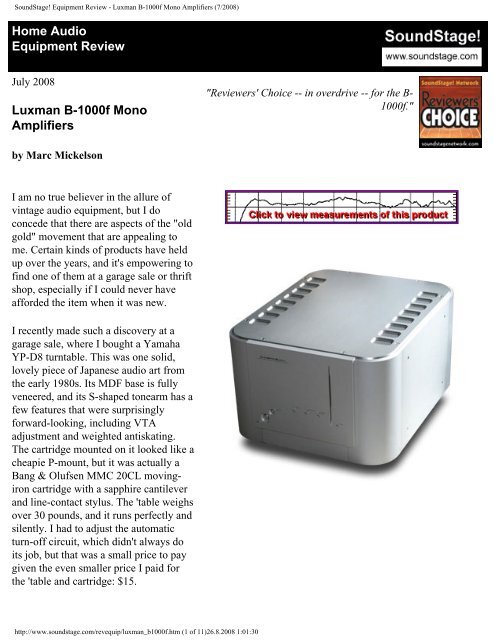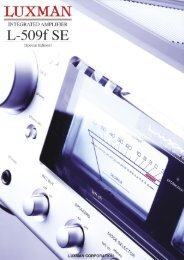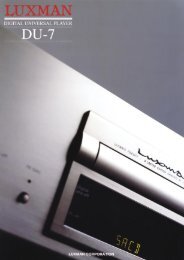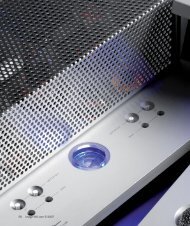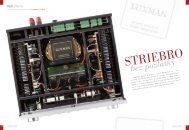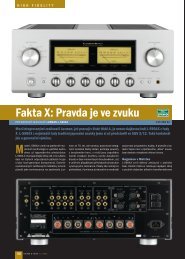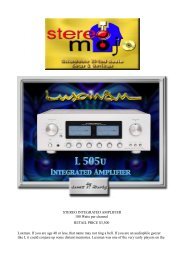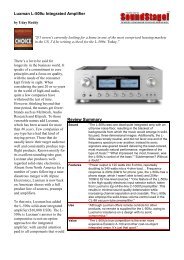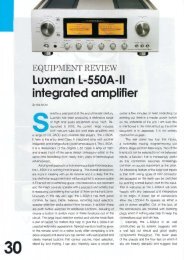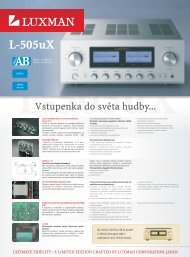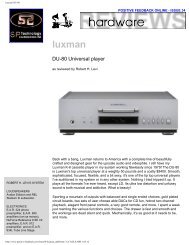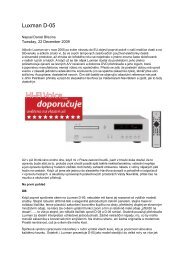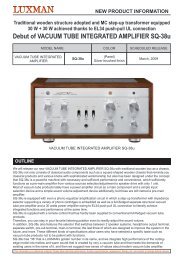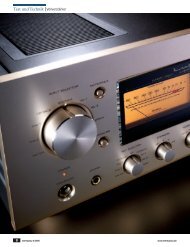Home Audio Equipment Review - Luxman
Home Audio Equipment Review - Luxman
Home Audio Equipment Review - Luxman
Create successful ePaper yourself
Turn your PDF publications into a flip-book with our unique Google optimized e-Paper software.
SoundStage! <strong>Equipment</strong> <strong>Review</strong> - <strong>Luxman</strong> B-1000f Mono Amplifiers (7/2008)<br />
<strong>Home</strong> <strong>Audio</strong><br />
<strong>Equipment</strong> <strong>Review</strong><br />
July 2008<br />
<strong>Luxman</strong> B-1000f Mono<br />
Amplifiers<br />
"<strong>Review</strong>ers' Choice -- in overdrive -- for the B-<br />
1000f."<br />
by Marc Mickelson<br />
I am no true believer in the allure of<br />
vintage audio equipment, but I do<br />
concede that there are aspects of the "old<br />
gold" movement that are appealing to<br />
me. Certain kinds of products have held<br />
up over the years, and it's empowering to<br />
find one of them at a garage sale or thrift<br />
shop, especially if I could never have<br />
afforded the item when it was new.<br />
I recently made such a discovery at a<br />
garage sale, where I bought a Yamaha<br />
YP-D8 turntable. This was one solid,<br />
lovely piece of Japanese audio art from<br />
the early 1980s. Its MDF base is fully<br />
veneered, and its S-shaped tonearm has a<br />
few features that were surprisingly<br />
forward-looking, including VTA<br />
adjustment and weighted antiskating.<br />
The cartridge mounted on it looked like a<br />
cheapie P-mount, but it was actually a<br />
Bang & Olufsen MMC 20CL movingiron<br />
cartridge with a sapphire cantilever<br />
and line-contact stylus. The 'table weighs<br />
over 30 pounds, and it runs perfectly and<br />
silently. I had to adjust the automatic<br />
turn-off circuit, which didn't always do<br />
its job, but that was a small price to pay<br />
given the even smaller price I paid for<br />
the 'table and cartridge: $15.<br />
http://www.soundstage.com/revequip/luxman_b1000f.htm (1 of 11)26.8.2008 1:01:30
SoundStage! <strong>Equipment</strong> <strong>Review</strong> - <strong>Luxman</strong> B-1000f Mono Amplifiers (7/2008)<br />
Back in the early 1980s, if I had been<br />
able to upgrade from my lowly BSR<br />
turntable to this luxe Yamaha, I would<br />
have dreamed about matching it with a<br />
<strong>Luxman</strong> amp and preamp. One of Japan's<br />
most distinguished names, <strong>Luxman</strong> was<br />
once well known here in the US, only to<br />
disappear, causing us Yanks to wonder if<br />
the company had gone under. Well, it<br />
hadn't. <strong>Luxman</strong> products were poorly<br />
distributed in the US, then not distributed<br />
at all. But <strong>Luxman</strong> was still a prestige<br />
name in Europe and Japan, where its<br />
digital products especially were<br />
celebrated, but it was a no show in the<br />
US for more than a decade.<br />
That changed late in 2006, when Philip<br />
O'Hanlon of On a Higher Note began<br />
bringing <strong>Luxman</strong> products back to<br />
America. Philip had previously<br />
distributed Halcro in the US, and I'm sure<br />
the <strong>Luxman</strong> product line represented a<br />
big change for him. Halcro had a few<br />
amps and a preamp, while <strong>Luxman</strong> has<br />
multiple amps, preamps, integrated<br />
amps, and digital components, along<br />
with a phono stage and a headphone amp<br />
-- almost two dozen products in total,<br />
some fully solid state and others using<br />
tubes. When Philip first visited me on his<br />
way to a dealer seminar, his minivan was<br />
packed to the ceiling with <strong>Luxman</strong><br />
boxes; he would have needed a trailer to<br />
bring along an example of every current<br />
<strong>Luxman</strong> product.<br />
<strong>Review</strong> Summary<br />
Sound "There is nothing vintage or nostalgic about<br />
this monster amp's sound, which has the kind<br />
of neutrality expected from today's best solidstate<br />
amps along with the power to make any<br />
speaker give in to its authority. However, none<br />
of this comes at the expense of body or<br />
presence." "There is also tremendous low-end<br />
detail, the ability to start and stop with the<br />
music and control even big woofers with<br />
seeming ease." "The B-1000f has a core set of<br />
musical strengths that even a committed tube<br />
lover like me can appreciate -- and value."<br />
Features "All of this leads to an amplifier with some<br />
impressive specifications, including a 250-watt<br />
power rating -- the first 30 in class A -- that<br />
doubles as impedance is halved." "Let's start<br />
with the EI transformer -- a 55-pound<br />
handmade power plant. Instead of having a<br />
core wound from round copper wire, as is<br />
usual, the core of the B-1000f's transformer is<br />
made from paper-covered flat copper bar."<br />
"The circuit boards look unusual. Then it hits<br />
you: The traces have no right angles, every<br />
one of them curving gracefully around the<br />
other. Again, the engineers at <strong>Luxman</strong> simply<br />
like how this sort of board layout sounds."<br />
Use "The B-1000f amps need ample warm-up time<br />
before they sound their best. Figure on at least<br />
45 minutes from standby to music playing<br />
before the amps achieve liquidity, ease and<br />
openness."<br />
Value "Such engineering expertise and sonic<br />
performance don't come cheap, but <strong>Luxman</strong>'s<br />
product line is deep, so there are choices<br />
appropriate for just about every budget."<br />
But as anyone who knows him is aware, Philip is all about the music, including recordings that few<br />
people have heard -- high-resolution versions of well-known albums, unreleased mixes, demos and the<br />
like. "Have I played this for you?" and "I can't give you a copy of this" pepper his talk whenever he visits.<br />
On a recent trip, he brought along a ReVox reel-to-reel player, some of the magnificent tapes from the<br />
Tape Project, and some line-topping <strong>Luxman</strong> products: the C-1000f preamp and B-1000f mono<br />
amplifiers. We installed the electronics first, did some listening to CDs, and then moved on to the tapes.<br />
After just a few cuts, it was apparent to me that I needed to write about the <strong>Luxman</strong> electronics, so<br />
http://www.soundstage.com/revequip/luxman_b1000f.htm (2 of 11)26.8.2008 1:01:30
SoundStage! <strong>Equipment</strong> <strong>Review</strong> - <strong>Luxman</strong> B-1000f Mono Amplifiers (7/2008)<br />
obvious was their sonic appeal. Philip agreed to leave everything with me -- he's trusting on top of being a<br />
musical omnivore -- and let me decide what I wanted to write about. While both the preamp and amps<br />
deserve some coverage, I chose the B-1000f's, because, well, you'll see why.<br />
Heavy metal<br />
The B-1000f mono amps are massive -- measuring 17"W x 21"D x 11 1/2"H and weighing somewhere<br />
north of 140 pounds each -- and massively expensive at $48,000 USD per pair. Such prices aren't out of<br />
the ordinary for top-of-the-line mono amps today, especially ones coming from foreign countries, but<br />
when you discover some of what goes into a B-1000f, you start to understand why this amp costs so<br />
much, even if you still can't write the check for a pair.<br />
http://www.soundstage.com/revequip/luxman_b1000f.htm (3 of 11)26.8.2008 1:01:30
SoundStage! <strong>Equipment</strong> <strong>Review</strong> - <strong>Luxman</strong> B-1000f Mono Amplifiers (7/2008)<br />
The B-1000f's transformer module.<br />
Let's start with the EI transformer -- a 55-pound handmade power plant. Instead of having a core wound<br />
from round copper wire, as is usual, the core of the B-1000f's transformer is made from paper-covered flat<br />
copper bar. Thick and unyielding, this is actually hammered into place, allowing for a tighter wind.<br />
<strong>Luxman</strong> prefers the sound of its copper bar to that of any round wire and, in this application, dislikes the<br />
sound of any outer coating other than paper. There is only one person at <strong>Luxman</strong> who makes these<br />
transformers, and each one is so time-consuming to produce that he spends his week making all of three.<br />
Even I can decipher this math: Three transformers means that <strong>Luxman</strong> can produce a maximum of three<br />
B-1000f's per week.<br />
The fanaticism doesn't end at the transformer. The circuit boards look unusual. Then it hits you: The<br />
traces have no right angles, every one of them curving gracefully around the other. Again, the engineers at<br />
<strong>Luxman</strong> simply like how this sort of board layout sounds. Like other companies, <strong>Luxman</strong> is picky about<br />
passive parts, but this is taken to a new level, as <strong>Luxman</strong> even chooses the paint that appears on the<br />
resistors it uses for reasons having to do with the paint's effect on the sound. I admire such devotion to<br />
sonic purity, even if I can't quite get my head around the way in which paint may make one resistor sound<br />
different from another.<br />
All of this leads to an amplifier with some impressive specifications, including a 250-watt power rating<br />
(the first 30 in class A) that doubles as impedance is halved. More math: This means the B-1000f will<br />
output 500 watts into 4 ohms, 1000 watts into 2 ohms, and 2000 watts into 1 ohm -- a punishing load, but<br />
one this amp was created to drive. Quoted frequency response is DC-150kHz, with a 118dB signal-tonoise<br />
ratio that pushes theoretical limits. Each amp draws 439 watts at its rated power, though there is<br />
thankfully a standby mode that keeps important circuitry warm, the amp drawing less than 1 watt.<br />
In comparison to the front panel of most amps, which sports only a power switch, the B-1000f's front<br />
panel is packed with features. There are pushbuttons for choosing the balanced inputs (the B-1000f is<br />
fully balanced, so you should use these if you can), absolute phase (pin 3 hot is the default, which is in<br />
phase in Japan but out of phase here in North America) and -4dB attenutation (which lowers the amp's<br />
voltage gain). There is also a lighted meter that pulsates with the music, roughly indicating the power<br />
output of each amp. I didn't find the meter bothersome, and there were times when I thought an especially<br />
big transient was struck, and looking at the meters confirmed this. But I listen mostly with eyes shut. If<br />
the meter bugs you to no end there's a button for turning it off. There are also pushbuttons for turning the<br />
amp on and taking it out of standby.<br />
http://www.soundstage.com/revequip/luxman_b1000f.htm (4 of 11)26.8.2008 1:01:30
SoundStage! <strong>Equipment</strong> <strong>Review</strong> - <strong>Luxman</strong> B-1000f Mono Amplifiers (7/2008)<br />
What will first catch your eye around back are the sturdiest gold-plated five-way binding posts you'll ever<br />
see. Their caps are like small doorknobs, and they allow you to torque down on speaker cables without the<br />
use of tools. There are two sets, making biwiring easy. There are RCA and XLR inputs along with an IEC<br />
power-cord inlet that's near the bottom of the amp, so the cord isn't in the way of the other connections.<br />
Even the IEC receptacle isn't left well enough alone, beginning with high-purity brass parts that are plated<br />
once with non-magnetic nickel and then gold. A feature I've never seen on any piece of electronics is a<br />
line-phase sensor, which, after you push it, will glow red if the live and neutral lines of the outlet into<br />
which the B-1000f is plugged are reversed. <strong>Luxman</strong> included a pair of sturdy handles on the back panel.<br />
You can pick the amp up with these, but enlist the help of a strong friend instead of going it alone. There<br />
are also jacks for remote turn on and off of the amp.<br />
Even the packaging is fanatically designed, with boxes that make packing and unpacking an easier job.<br />
The boxes have illustrations on the outside showing how everything fits together. As a final touch of<br />
luxury, <strong>Luxman</strong> packages a custom power cord along with each B-1000f -- no computer-grade throwaway<br />
included for the sake of completeness. The owner's manual is in Japanese only at this point, but Philip<br />
O'Hanlon is busy translating.<br />
http://www.soundstage.com/revequip/luxman_b1000f.htm (5 of 11)26.8.2008 1:01:30
SoundStage! <strong>Equipment</strong> <strong>Review</strong> - <strong>Luxman</strong> B-1000f Mono Amplifiers (7/2008)<br />
Used with…<br />
The B-1000f amps were hardly slumming it in my system; they were surrounded with likewise pricey and<br />
extreme equipment. Speakers were Wilson <strong>Audio</strong> MAXX 2s or Alexandria X-2 Series 2s, both of which<br />
reached some new sonic levels driven by the ultra-beefy B-1000f's. Preamps were the matching solid-state<br />
<strong>Luxman</strong> C-1000f, which costs a cool $30,000, an <strong>Audio</strong> Research Reference 3, and an Aurum Acoustics<br />
CDP preamp/CD player. Digital sources were the Aurum CDP, an Ayre C-5xe universal player, and a<br />
Zanden 2000P CD transport connected via Zanden's I 2 S cable to its mate, the Model 5000S DAC. Analog<br />
playback came courtesy of a TW-Acustic Raven AC turntable on which were mounted a Graham<br />
Phantom tonearm and Dynavector DRT XV-1s stereo and mono cartridges -- one Graham armwand for<br />
each. Phono stages were the highly flexible internal one for the Aurum CDP, a Lamm LP2 Deluxe, and an<br />
<strong>Audio</strong> Research PH7. Other amps for comparison were Lamm M1.2 Reference monoblocks and an <strong>Audio</strong><br />
Research Reference 110 stereo amp.<br />
Cables were mostly <strong>Audio</strong>Quest William E. Low Signature speaker cables and balanced interconnects,<br />
augmented with some <strong>Audio</strong>Quest Sky interconnects. Near the very end of my time with the <strong>Luxman</strong><br />
amps, I was able to connect everything with Shunyata Research's new Aeros-series interconnects and<br />
speaker cables. Tonearm cables were a Furutech Ag-12 or <strong>Audio</strong>Quest LeoPard. Power cords were either<br />
Essential Sound Products Essence Reference or Shunyata Research Anaconda Helix or Python Helix in<br />
both Vx and Alpha variations. As I mentioned, <strong>Luxman</strong> supplies a nicely wrought power cord with each<br />
B-1000f, but I stuck with the other cords simply because I know their contributions to the sound of my<br />
system. Everything, including the amps, was plugged into a Shunyata Hydra V-Ray power conditioner or<br />
an ESP Essence Reference power distributor.<br />
The literal centerpiece of my system is a Silent Running <strong>Audio</strong> Craz 4 Reference rack, which is a rocksolid<br />
platform for the TW-Acustic turntable and its 100+ pounds. The Lamm amps likewise rested on<br />
SRA platforms. A pair of Harmonic Resolution Systems M3 bases supported the Zanden transport and<br />
DAC.<br />
The B-1000f amps need ample warm-up time before they sound their best. Figure on at least 45 minutes<br />
from standby to music playing before the amps achieve liquidity, ease and openness. In use, the B-1000f's<br />
run hot to the touch, but they don't emit a noticeable amount of heat. My room is very big -- 20'W x 29'L<br />
with a 10' ceiling -- and only the toastiest of tube amps make a dent in such square footage. Once the<br />
amps were powered up, I generally left them on for the day, their partially class-A output no doubt putting<br />
a dent in our power bill. The amps were perfectly stable and made not a discouraging sound for the two<br />
solid months they were in my system.<br />
Japanese muscle<br />
While <strong>Luxman</strong> may be a grand old name in high-performance audio, the B-1000f proves that the<br />
company's best products are not in the past. There is nothing vintage or nostalgic about this monster amp's<br />
sound, which has the kind of neutrality expected from today's best solid-state amps along with the power<br />
to make any speaker give in to its authority. However, none of this comes at the expense of body or<br />
presence. While I wouldn't call the B-1000f a tubey-sounding solid-state amp, neither would I liken its<br />
http://www.soundstage.com/revequip/luxman_b1000f.htm (6 of 11)26.8.2008 1:01:30
SoundStage! <strong>Equipment</strong> <strong>Review</strong> - <strong>Luxman</strong> B-1000f Mono Amplifiers (7/2008)<br />
sound to that of some of its solid-state competition, which can sound sterile, more like a piece of<br />
laboratory equipment than a power amplifier. The B-1000f has a core set of musical strengths that even a<br />
committed tube lover like me can appreciate -- and value.<br />
Where the B-1000f's ability to "double down" -- double its power output as load impedance is halved --<br />
has obvious effect is in the bass, which is where things can get a little (or a lot) hairy with speaker<br />
impedance, especially when multiple woofers are involved. The B-1000f's bass simply goes lower and<br />
with greater linearity than that of any amp I've heard. There is also tremendous low-end detail, the ability<br />
to start and stop with the music and control even big woofers with seeming ease. The Wilson <strong>Audio</strong><br />
MAXX 2s and X-2 Series 2 speakers can provide bass depth that outclasses that of most subwoofers, even<br />
some that are highly touted, and when driven by the B-1000f's, these speakers can almost literally rock the<br />
house.<br />
Back when I was in college, one of my roommates played side one of Talking Heads Stop Making Sense<br />
LP [Sire W1-25186] every morning before class, often while I was still sleeping. I grew to know the<br />
throbbing bass of those songs -- "Psycho Killer" to "Girlfriend is Better" -- better than the lyrics or<br />
melodies. So when I found a very clean copy of this album at a garage sale, I couldn't wait to hear what<br />
the <strong>Luxman</strong> amps could do with it. The bass range was completely devoid of the loudness-control bloat<br />
burned into my memory, and it was replaced by snap and punch that were impressive for their pistonic<br />
start and stop. When I wanted to test bass depth, I pulled out Tracy Chapman's CD Where You Live<br />
[Elektra 83803-2] to hear the throbbing tones of "3,000 Miles." Other amps bring more weight to this very<br />
low bass, but the <strong>Luxman</strong> monoblocks tracked this energy down to its very bottom, pressurizing my<br />
listening room like an incoming storm front. There is no trick to such bass, no adornment that impresses<br />
at first but becomes tiresome after a while. In the B-1000f's case, the bass is further evidence of the<br />
amplifier's dominant neutrality -- the ideal of conveying what's recorded with the utmost faithfulness.<br />
While the B-1000f is going to give you<br />
the truth, it won't do so in the way that<br />
some other amplifiers present it. Solidstate<br />
amps often take a hit for their gaunt<br />
midrange, vocalists losing all sense that<br />
there's a body behind whatever they sing.<br />
In contrast, the midrange of the B-1000f<br />
has some weight and palpability -- not so<br />
much that they season every part of the<br />
musical signal or are even plainly<br />
obvious, but just enough to make you<br />
move on to consider something else<br />
about what you're hearing. Warm<br />
recordings, whether analog or digital,<br />
sound warm but never to excess, while<br />
the leanness in other recordings will be<br />
duly noted, not force you to look for<br />
something else to play. This is the truth --<br />
The littler <strong>Luxman</strong><br />
Intrigued by the B-1000f's but don't have the nearly $50k<br />
required to buy 'em? While not exactly a budget-minded<br />
product at $16,000, the <strong>Luxman</strong> M-800A is one-third the<br />
B-1000f's price, one-quarter its power output (60Wpc<br />
versus 250 watts each) and about 70% of the B-1000f's<br />
performance contained in a similarly well-designed and<br />
attractive package.<br />
Sonically speaking, what you get from the M-800A is<br />
much of the low-end prowess of the B-1000f, along with<br />
the more expensive amp's matter-of-fact midrange and<br />
way with space. Tone and timbre are fundamentally<br />
neutral and true to life, with piano well delineated and<br />
portrayed authoritatively in its lowest registers, where<br />
the power reserves of this amp become apparent. I<br />
especially enjoyed the moody jazz of the ECM label with<br />
http://www.soundstage.com/revequip/luxman_b1000f.htm (7 of 11)26.8.2008 1:01:30
SoundStage! <strong>Equipment</strong> <strong>Review</strong> - <strong>Luxman</strong> B-1000f Mono Amplifiers (7/2008)<br />
the sense that a recording sounds as it<br />
should and that that the <strong>Luxman</strong><br />
amplifiers don't push it to excess one<br />
way or another -- and it's one of the most<br />
endearing things about the B-1000f<br />
monoblocks, something that will lead to<br />
long-term happiness and lots of listening.<br />
Piano comes alive with the B-1000f's,<br />
likely because of their effortless power<br />
and ability to delineate instruments from<br />
each other, casting them in whatever<br />
sense of space is captured on the<br />
recording. Again, neutrality rules, the B-<br />
1000f amps not adding in or subtracting<br />
from what's recorded. Hampton Hawes is<br />
maybe the most under-appreciated<br />
pianist from jazz's heydays in the 1950s<br />
and '60s. Hawes was a sympathetic<br />
interpreter who played into tunes, turning<br />
them into something that connected on a<br />
level below cognition. He made a series<br />
of trio recordings, plainly subtitled Vol.<br />
1, Vol. 2 and Vol. 3, not to be confused<br />
with the three All Night Session!<br />
recordings. The trio collections are<br />
among his very best, and on This is<br />
Hampton Hawes - Vol.2, The Trio<br />
[Fantasy OJC-318] dynamics were<br />
portrayed with realistic scaling, the<br />
ability to soar from soft to very loud, and<br />
the notes popped, enhancing appreciation<br />
of Hawes' elegant playing.<br />
the M-800A. These recordings can sound dry, but they<br />
worked with the M-800A, which conveyed the unique<br />
mixture of atmosphere and challenging music on Dino<br />
Saluzzi and Anja Lechner's Ojos Negro [ECM 1991] with<br />
a tube amp's spatial acumen.<br />
What I found most surprising, however, is that while the<br />
M-800A is rated at 60Wpc, it never compressed<br />
dynamically or gave other signs of running out of power<br />
with the Wilson <strong>Audio</strong> MAXX 2s. Speakers and amp<br />
played at nearly rave-approved levels for as long as I<br />
could tolerate it. On the other end of the volume<br />
spectrum, M-800A was very quiet, never obscuring fine<br />
detail amidst its own noise. Where the B-1000f<br />
monoblocks pull ahead is in the effortlessness of their<br />
sound at all levels, their ability to find another level of<br />
bass depth with speakers that have it, their slightly<br />
greater midrange purity, and their standard-setting<br />
dynamic range. Still, it's obvious that the M-800A comes<br />
from people with the same mindset: push the limits of<br />
dynamic expression while delivering a clean though not<br />
expressly lean or bleached tone. The M-800A<br />
accomplishes this better than any amp other than the B-<br />
1000f.<br />
The M-800A also gives you an intriguing platform for<br />
even greater sonic performance: It can be bridged to<br />
mono, in which case it quadruples its power output and,<br />
I'm sure, inches even closer to its very big, very<br />
impressive brother. Still, with many speakers and at<br />
sane listening levels, you won't need any more amp than<br />
this.<br />
...Marc Mickelson<br />
marc@soundstage.com<br />
Small and large-scale dynamics were another obvious strength of the <strong>Luxman</strong> amps. At low levels, detail<br />
was never absorbed by the amps' noise floor, which is very low, even by the ear-to-the-tweeter test, but<br />
when the music roars, the B-1000f's presented it in all its raw power. Here again, piano was a great test, as<br />
the same instrument that is capable of delicacy is also able to convey thunderous power. The <strong>Luxman</strong><br />
amps handled the extremes with ease.<br />
What you won't get from the B-1000f really comes as no great surprise: the midrange sophistication of a<br />
great tube amp -- the unique combination of warmth, texture, and roundness that can bring music to life.<br />
Of course, the question is whether these are pleasing colorations -- things an amplifier adds to the signal --<br />
or recorded treasure somehow buried from the unerring neutrality of the solid-state B-1000f. I know what<br />
http://www.soundstage.com/revequip/luxman_b1000f.htm (8 of 11)26.8.2008 1:01:30
SoundStage! <strong>Equipment</strong> <strong>Review</strong> - <strong>Luxman</strong> B-1000f Mono Amplifiers (7/2008)<br />
I like, and I like an attention-grabbing midrange; still, while I listened to the B-1000f, I never felt<br />
deprived.<br />
In fact, the more I listened to these amps, especially in conjunction with the matching top-of-the-line<br />
<strong>Luxman</strong> C-1000f preamp, the more I liked them, which is a rare occurrence with solid-state gear in my<br />
system. I began playing more vinyl with the <strong>Luxman</strong> electronics, marveling at the imaging, the<br />
spaciousness, and the whomping bass. At no point did I want to switch to other electronics, even to hear<br />
how a different amp or preamp might portray a particular recording. More than any one thing about the<br />
sonic signature of this gear, I will remember the weeks of listening I did with the B-1000f's, only<br />
considering what equipment I was listening to when my reviewer subroutine was running. And I can do<br />
with less of that!<br />
Monoblock y monoblock<br />
My admiration for Vladimir Lamm's amplifiers -- all of 'em -- remains absolute: I have owned Lamm<br />
amplifiers, which I have used as my reference, for a very long time, and their pairing with Wilson <strong>Audio</strong><br />
speakers exists on a level where synergy gives way to something greater -- a sympathetic idea of what<br />
great reproduced sound is. Above all, Lamm amplifiers sound organic and whole, able to convey the<br />
detail on recordings in an intimately real way that I find especially meaningful. Even after reviewing other<br />
amplifiers, some of which have impressed me greatly, I am always happy to revisit the Lamm amps,<br />
which bring me home, sonically speaking.<br />
These days, after longtime use of Lamm tube amps -- the ML1.1 and ML2.1 -- I have settled on the M1.2<br />
Reference monoblocks ($22,290 per pair). Because of their hybrid circuit -- tube input, solid-state output<br />
-- and greater power, they are more widely usable for reviewing purposes than their tube mates, and they<br />
always sound like a Lamm amp, giving me extreme pleasure in the rare instances when I'm listening for<br />
the heck of it, not to suss what a review component is all about, Alfie.<br />
So, right in the middle of my very enjoyable time with the <strong>Luxman</strong> amps, I reconnected the M1.2s. People<br />
often write me wondering how one product compares to another, when in reality it's the contrasts that<br />
they're really wondering about. With the <strong>Luxman</strong> and Lamm amps, the contrasts were striking. I<br />
immediately responded to the M1.2s' midrange warmth and bass weight, writing in my listening notes,<br />
"Boy, I miss all that." These things give the Lamm amps a full, palpable sound that's different from that of<br />
the <strong>Luxman</strong> amps, which sound lighter and brighter though never lean and bleached. In the bass, the<br />
Lamm amps counter the tremendous depth of the <strong>Luxman</strong> amps with greater apparent heft, which can<br />
actually give the illusion of greater bass depth. The <strong>Luxman</strong> amps just dig deeper, remaining honest to<br />
their very depths and giving no sign of sonic additives. Still, the weight of the Lamm amps' bass can be<br />
very pleasing, especially with LPs like Stop Making Sense, though the <strong>Luxman</strong> amps clearly go deeper --<br />
and go deeper clearly.<br />
In the mids, the tubes of the Lamm amps are all the more obvious when the sound of the amps is set<br />
against the fidelity of the <strong>Luxman</strong> monoblocks. The Lamm amps cast a full, physical soundstage, one<br />
that's not short on recorded space, while the <strong>Luxman</strong> amps cast solid images amidst a spacious<br />
soundstage. This might seem like a picky distinction to make, but it's not. You first note the physicality of<br />
http://www.soundstage.com/revequip/luxman_b1000f.htm (9 of 11)26.8.2008 1:01:30
SoundStage! <strong>Equipment</strong> <strong>Review</strong> - <strong>Luxman</strong> B-1000f Mono Amplifiers (7/2008)<br />
the Lamm amps, while with the <strong>Luxman</strong> amps the physicality comes from the substantial way the<br />
musicians are rendered within the recorded space.<br />
More than the great difference in price, the choice between the Lamm and <strong>Luxman</strong> amps comes down to<br />
the view of music that appeals to you: obvious physicality versus obvious neutrality. With the Lamm<br />
amps, you get enough power to drive most speakers, while I seriously doubt the <strong>Luxman</strong> M-1000f's will<br />
run out of power with any speaker. I'd like to own both sets of amps, but I'm happy to have just one.<br />
Then and now<br />
Next month I will finish my tenth year as the editor of SoundStage!, and I can only guess how many<br />
reviews of amplifiers I've written over the course of that decade. As I think back about all of the amps I've<br />
heard, or at least the ones that come easily to mind, I can remember none that seemingly incorporates the<br />
strengths of them all better than the <strong>Luxman</strong> B-1000f. It has a fundamentally neutral signature, standardsetting<br />
bass depth and linearity, and doesn’t display obvious colorations that will cause you to revoice<br />
your system to overcome them. There's no solid-state leanness or tubelike warmth, no bass bloat that<br />
gives the illusion of power, no zingy treble. There's just an open window on the intrinsic sound of the<br />
recording, a sonic character that passes on the signal fed to it with great detail and dynamic expression.<br />
Such engineering expertise and sonic performance don't come cheap, but <strong>Luxman</strong>'s product line is deep,<br />
so there are choices appropriate for just about every budget.<br />
With the B-1000f, <strong>Luxman</strong> has returned to America with a bang. Just as in the automobile industry, the<br />
established names in American hi-fi -- Mark Levinson, Krell, Boulder and others -- now have some stiff<br />
competition from Japan. <strong>Review</strong>ers' Choice -- in overdrive -- for the B-1000f.<br />
...Marc Mickelson<br />
marc@soundstage.com<br />
<strong>Luxman</strong> B-1000f Mono Amplifiers<br />
Price: $48,000 USD per pair.<br />
Warranty: Five years parts and labor.<br />
<strong>Luxman</strong> Corporation<br />
1-3-1 Shin-Yokohama Kouhoku-ku<br />
Yokohama, Japan 222-0033<br />
Phone: +81 45 470 6980<br />
Fax: +81 45 470 6997<br />
Website: www.luxman.co.jp<br />
US distributor:<br />
On a Higher Note, LLC<br />
http://www.soundstage.com/revequip/luxman_b1000f.htm (10 of 11)26.8.2008 1:01:30
SoundStage! <strong>Equipment</strong> <strong>Review</strong> - <strong>Luxman</strong> B-1000f Mono Amplifiers (7/2008)<br />
26081 Via Estelita<br />
San Juan Capistrano, CA 92675<br />
Phone: (949) 488-3004<br />
Fax:: (949) 488-3284<br />
E-mail: info@onahighernote.com<br />
Website: www.onahighernote.com<br />
●<br />
Current Issue <strong>Equipment</strong> <strong>Review</strong>s<br />
All Contents<br />
Copyright © 2008 SoundStage!<br />
All Rights Reserved<br />
http://www.soundstage.com/revequip/luxman_b1000f.htm (11 of 11)26.8.2008 1:01:30


